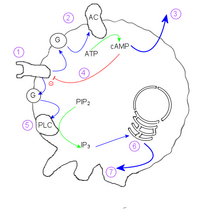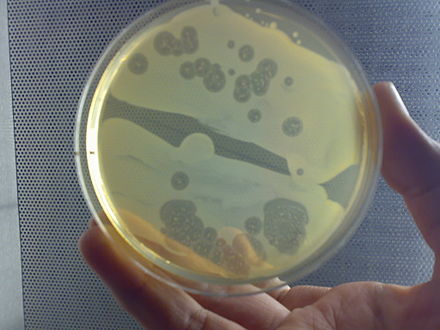Dictyostelid
The dictyostelids (Dictyostelia/Dictyostelea, ICZN, or Dictyosteliomycetes, ICBN) are a group of cellular slime molds, or social amoebae.
When food (normally bacteria) is readily available dictyostelids behave as individual amoebae, which feed and divide normally. However, when the food supply is exhausted, they aggregate to form a multicellular assembly, called a pseudoplasmodium, grex, or slug (not to be confused with the gastropod mollusc called a slug). The grex has a definite anterior and posterior, responds to light and temperature gradients, and has the ability to migrate. Under the correct circumstances the grex matures forming a sorocarp (fruiting body) with a stalk supporting one or more sori(balls of spores). These spores are inactive cells protected by resistant cell walls, and become new amoebae once food is available.
In Acytostelium, the sorocarp is supported by a stalk composed of cellulose, but in other dictyostelids the stalk is composed of cells, sometimes taking up the majority of the original amoebae. With a few exceptions, these cells die during stalk formation, and there is a definite correspondence between parts of the grex and parts of the fruiting body. Aggregation of amoebae generally takes place in converging streams. The amoebae move using filose pseudopods, and are attracted to chemicals produced by other amoebae. In Dictyostelium, aggregation is signalled by cAMP, but others use different chemicals. In the species Dictyostelium purpureum, the grouping is by kinship, not just by proximity.
Dictyostelium has been used as a model organism in molecular biology and genetics, and is studied as an example of cell communication, differentiation, and programmed cell death. It is also an interesting example of the evolution of cooperation and cheating.[1][2][3] A large body of research data concerning D. discoideum is available on-line at DictyBase.
The mechanism behind the aggregation of the amoebae relies on cyclic adenosine monophosphate (cAMP) as a signal molecule. One cell, the founder of the colony, begins to secrete cAMP in response to stress. Others detect this signal, and respond in two ways:
The effect of this is to relay the signal throughout the nearby population of amoebae and cause inward movement to the area of highest cAMP concentration.


